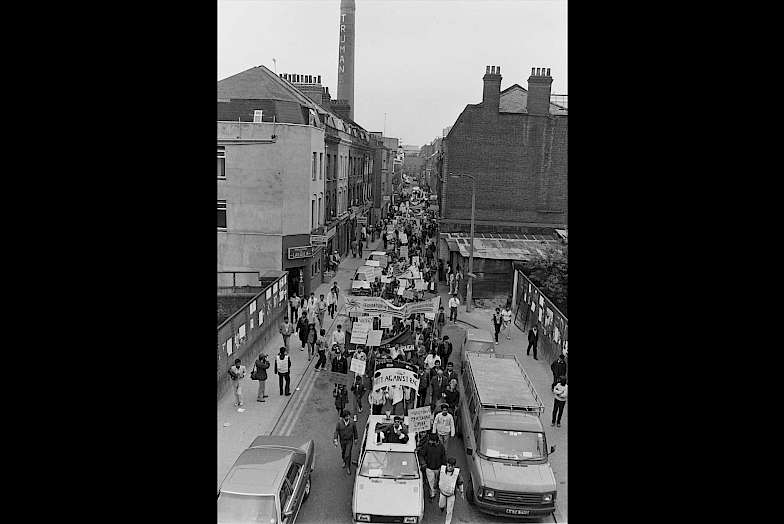As a place of migration, Brick Lane also has a long tradition of racist and anti-racist mobilisation.
From the late nineteenth and early twentieth centuries, Jewish refugees in the East End were confronted with violent anti-Semitism. The British Brothers’ League, an alliance between East End workers and backbench Tory MPs founded in 1901, dominated the organised response to Jewish migration in the East End. The League operated under the slogan ‘England for the English’ and between 1901 and 1905 marched in rallies through the streets of Shoreditch, Bethnal Green and Limehouse. The League was countered by Jewish people involved in the Aliens Defence League, an anti-racist organisation temporarily housed in Brick Lane.
The 1930s witnessed the rise of fascism in Europe. In Britain, the British Union of Fascists was formed in 1932 by Oswald Mosley and led anti-Semitic attacks on Jewish people and their property in the East End. In 1936, anti-racist activists and locals, who had built barricades to stop the British Union of Fascists from marching through Spitalfields, clashed with police in what has come to be known as ‘The Battle of Cable Street’. This was a precursor to the anti-racist struggles of the Bengalis in the same area in the 1970s.
The significance of Brick Lane for Bangladeshis who live and work in the area is centred on the struggle against racism that many of them had waged when they arrived in Britain. As greater numbers of Bangladeshis began to arrive in Tower Hamlets in the 1970s, they were subjected to constant racism. This period saw the growth of the National Front in Britain, a far-right, fascist political party. The National Front concentrated its activity in the East End and deliberately sold its publication on Brick Lane during Sunday Market. Skinhead gangs frequently launched violent racist attacks against Bangladeshi people, their homes and businesses – including Brick Lane’s curry restaurants.
A former local resident and community worker said of this period:
‘It was scary, because you never knew what you'd face when you stepped out of your home and you went out. Being abused, being ridiculed, being called names was a regular thing. You know, you're walking down the street, and some guy driving down would shout at you, throw things at you.’
A Brick Lane curry restaurant owner recalled his own experience of the 1970s. He said:
'76, '77, '78 was a difficult time for the immigrant people of this area.’
He continued:
‘Even on market days you’d see the group of skinhead and things like that, they were shouting, screaming.’
In the mid-1970s and early 1980s, Brick Lane was transformed into a site of organised anti-racist resistance from within the Bengali community. The strength of this organising was prompted by the racist murder of Altab Ali in May 1978. The 25-year-old clothingworker was walking home through Brick Lane after a late shift at work when he was attacked, chased and stabbed to death by a gang of teenagers. The local Bangladeshi community, especially young people, became politicised by the murder and mobilised to demand change. On the day of Ali’s funeral, thousands of Bengalis and their allies marched behind his coffin from Brick Lane to Downing Street. St Mary’s Park on the south side of Brick Lane, where Ali was murdered, was officially renamed Altab Ali Park in 1998.
The following month, in June 1978, gangs of white youth terrorised the Brick Lane area, breaking windows and damaging cars and shops. In response, the Anti-Nazi League organised an anti-racist march which included people of all backgrounds and ethnicities.
Following events in Brick Lane in 1978, the younger generation of Bengalis became increasingly vocal and active in their resistance to discrimination and victimisation. Various anti-racist youth groups emerged, supported by local government funding. Key among these were the Bangladesh Youth Movement, the Bangladesh Youth Front, Progressive Youth, Bangladesh Youth Association and the Bangladesh Youth League. They established links with other youth movements in London, Birmingham, Manchester, Bradford and Leicester. Together, these groups campaigned for equal opportunities in housing, employment, education and health.
Bangladeshis in the East End also experienced widespread discrimination in the housing market. Early arrivals were forced to live in private rented accommodation, which was overcrowded and unfit for family life. As wives and children began to arrive, Bengali families were allocated council or ex-council accommodation, often in the least popular and poorest-quality housing estates. From 1975, several hundred Bangladeshi families took direct political action by way of the Bengali squatters’ movement, the Bengali Housing Action Group and housing lobbies.
By the mid-1980s, many second-generation Bengali activists who had been involved in local youth movements had crossed into mainstream Labour Party politics as local councillors. Their aim was to continue advocating for better and fairer treatment for Bengalis.
Political activism in the East End’s Bangladeshi community was also transnational. While the second generation of Bengalis organised politically to tackle the problems faced by the community in Britain, like racism and discrimination in housing, the older generation in Britain maintained a keen interest in political developments in Bangladesh.
The British branch of the Awami League, the nationalist, secular party that led the movement for Bangladeshi independence, was formed in 1970. During the war of independence, Awami League members in Britain raised funds to send ‘home’ to support the Bangladeshi freedom struggle and held demonstrations in London in support of Bangladeshi independence. Today, the political views of the British Bangladeshi community vary between support for Bangladesh’s pro-Pakistani Muslim League, the centre-right Bangladesh National Party and the Awami League.
Brick Lane’s curry cafés and restaurants provided important meeting points for those Bengali’s active in anti-racist and political organising. The East Pakistan Liberation Front and the Bangladeshi Youth League, for example, regularly held their meetings in local restaurants.




